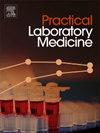Comparison of routine blood parameters by altitude and residence duration in the Western Sichuan Plateau
IF 1.7
Q3 MEDICAL LABORATORY TECHNOLOGY
引用次数: 0
Abstract
Background
This study explores how routine blood test parameters change over time in acclimatized individuals at different altitudes on the Western Sichuan Plateau.
Methods
Healthy men aged 20–40 from low-altitude areas who moved to Ganzi Prefecture to live and work were recruited. The observation sites were Guzan Town (1400 m), Kangding County Seat (2500 m), Luhuo County Seat (3400 m), and Litang County Seat (4100 m). Participants at the same altitude were grouped according to residence duration. The relationships between blood test parameters, altitude, and residence duration were analyzed.
Results
After moving to the plateau, white blood cell, red blood cell, hemoglobin, and hematocrit levels rose quickly in the short term, then declined and stabilized. In contrast, platelet levels increased steadily and were positively correlated with altitude.
Conclusions
Changes in blood parameters during high-altitude acclimatization are significant physiological responses to hypoxia and are affected by both altitude and residence duration.
求助全文
约1分钟内获得全文
求助全文
来源期刊

Practical Laboratory Medicine
Health Professions-Radiological and Ultrasound Technology
CiteScore
3.50
自引率
0.00%
发文量
40
审稿时长
7 weeks
期刊介绍:
Practical Laboratory Medicine is a high-quality, peer-reviewed, international open-access journal publishing original research, new methods and critical evaluations, case reports and short papers in the fields of clinical chemistry and laboratory medicine. The objective of the journal is to provide practical information of immediate relevance to workers in clinical laboratories. The primary scope of the journal covers clinical chemistry, hematology, molecular biology and genetics relevant to laboratory medicine, microbiology, immunology, therapeutic drug monitoring and toxicology, laboratory management and informatics. We welcome papers which describe critical evaluations of biomarkers and their role in the diagnosis and treatment of clinically significant disease, validation of commercial and in-house IVD methods, method comparisons, interference reports, the development of new reagents and reference materials, reference range studies and regulatory compliance reports. Manuscripts describing the development of new methods applicable to laboratory medicine (including point-of-care testing) are particularly encouraged, even if preliminary or small scale.
 求助内容:
求助内容: 应助结果提醒方式:
应助结果提醒方式:


